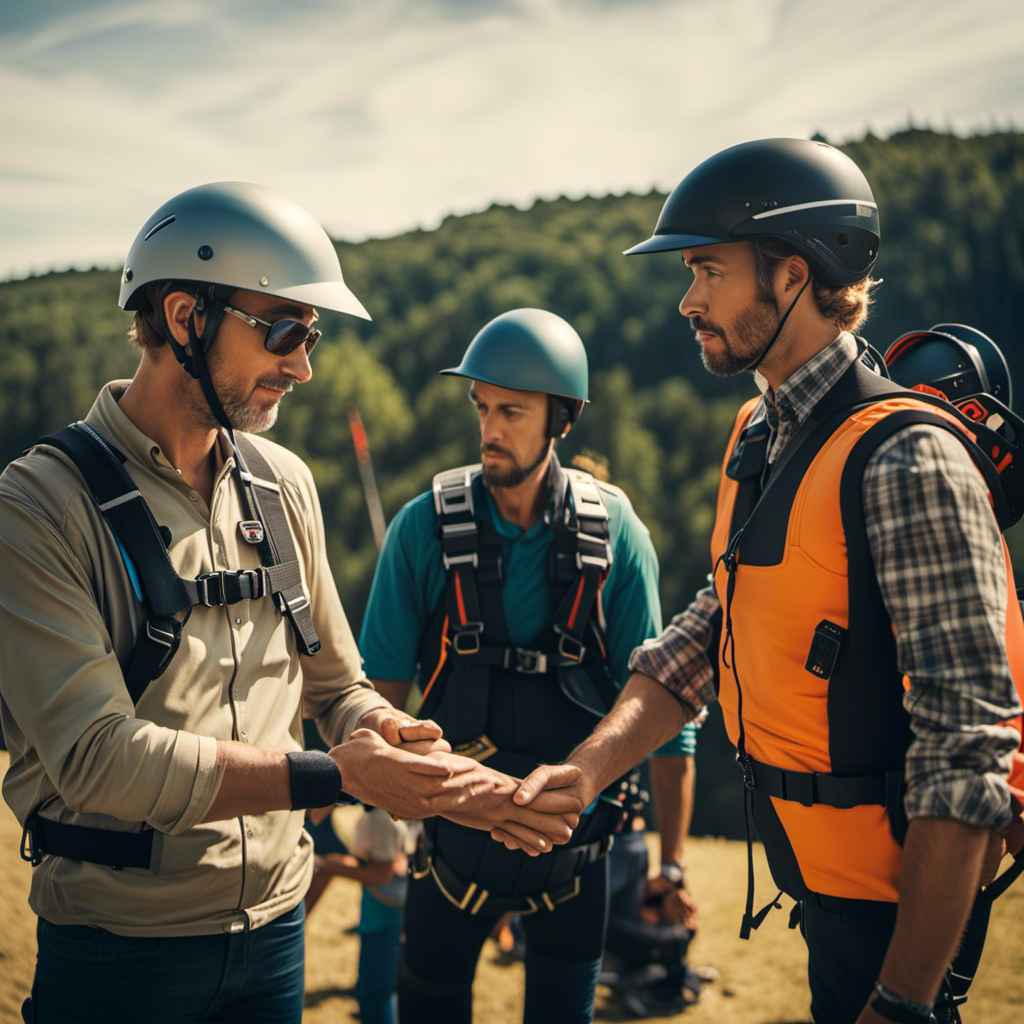Have you ever dreamt of soaring high in the sky, piloting a powerful aircraft with skill and confidence? You’ve come to the right place. In this comprehensive guide, I will walk you through the steps to becoming a pilot.
From researching the requirements to gaining flight experience, we will cover every step necessary to achieve your dream.
So, buckle up and get ready to embark on an exciting adventure towards a rewarding career in aviation. Let’s make your skyward calling a reality.
Key Takeaways
- Participate in internship programs and engage in simulator training to gain experience and enhance decision-making skills.
- Acquire advanced certifications and pursue specialized training to stand out in the competitive aviation industry.
- Continuously enhance skillset, seek diverse experiences, and network strategically to pursue career opportunities and advancement.
- Stay updated on aviation technology, regulations, and compliance requirements to be a valuable asset and stay ahead in the industry.
Research the Requirements and Prerequisites for Becoming a Pilot
To become a pilot, you’ll need to research the requirements and prerequisites. Understanding the potential career paths in aviation is crucial in determining the necessary qualifications. Whether you aspire to be an airline pilot, a military pilot, or a private pilot, each path has its own set of requirements and training programs.
Additionally, it is important to consider the cost and financial considerations of pilot training. Flight training can be expensive, and it is essential to plan and budget accordingly. Scholarships, loans, and financing options may be available to help offset the costs.
By thoroughly researching the requirements and understanding the financial aspects, you can make an informed decision and take the necessary steps towards becoming a pilot.
Now, let’s transition to the next section and discuss how to choose the right flight school.
Choose the Right Flight School
Start by researching different flight schools and find one that aligns with your goals and offers the training programs you need. When choosing the right flight school, there are several considerations to keep in mind:
-
Reputation: Look for flight schools with a strong reputation in the aviation community. This will ensure you receive high-quality training and increase your chances of success.
-
Facilities: Check if the flight school has well-maintained aircraft and modern training facilities. These factors will greatly impact your learning experience.
-
Instructors: Evaluate the qualifications and experience of the flight instructors. Expert guidance is crucial for your development as a pilot.
-
Costing: Consider the total cost of the training program, including tuition, fees, and additional expenses. Balancing affordability with quality is essential.
-
Location: Choose a flight school that is easily accessible and offers favorable weather conditions for training.
Now that you have chosen the right flight school, the next step is to obtain a student pilot certificate.
Obtain a Student Pilot Certificate
Once you’ve selected the right flight school, it’s important to obtain a student pilot certificate. This certificate is a crucial step in your journey to becoming a pilot. Not only does it serve as proof of your eligibility to fly solo, but it also provides several benefits.
First, it allows you to gain valuable flight experience under the supervision of a flight instructor. Second, it provides access to various resources and privileges, such as renting aircraft and participating in certain aviation events.
Obtaining a student pilot certificate involves three simple steps:
-
Complete the application form (FAA Form 8710-1) online or in-person at your local Flight Standards District Office (FSDO).
-
Schedule a visit to an Aviation Medical Examiner (AME) for a medical examination and obtain a medical certificate.
-
Finally, submit your application, along with the necessary supporting documents, to your FSDO.
With your student pilot certificate in hand, you can now move on to the next phase of your training: completing ground school.
Complete Ground School Training
When completing ground school training, you’ll gain knowledge and understanding of key aviation concepts and principles. This training is essential for aspiring pilots as it forms the foundation of their aviation education.
Ground school covers a wide range of topics, including aerodynamics, aircraft systems, meteorology, navigation, and regulations. One important aspect emphasized during ground school is the importance of simulator training. Simulators provide a safe and controlled environment for pilots to practice various flight scenarios and emergencies, helping them develop crucial decision-making and problem-solving skills.
Additionally, joining a flying club can provide aspiring pilots with valuable opportunities for additional training. Flying clubs often offer access to a variety of aircraft, flight instructors, and training resources, allowing students to gain more flight experience and build their confidence.
With ground school training completed, it’s time to move on to the next phase: starting flight training and logging flight hours.
Start Flight Training and Log Flight Hours
Now that you’ve completed ground school training, it’s time to dive into flight training and begin logging those valuable flight hours. This phase of your journey is crucial for building the skills and experience necessary to become a pilot.
Here are a few key points to keep in mind:
-
Flight simulation technology: Take advantage of advanced flight simulators to practice various flight scenarios, hone your skills, and familiarize yourself with different aircraft systems.
-
Importance of maintaining a flight log: Keep a detailed record of your flight hours, including the date, aircraft type, flight conditions, and maneuvers performed. This log serves as proof of your experience and is essential for meeting certification requirements.
Transitioning to the next phase of your training, it is important to pass both the written and practical exams to demonstrate your knowledge and proficiency in aviation.
Pass the Written and Practical Exams
To successfully pass the written and practical exams, you’ll need to study diligently and demonstrate your understanding of aviation regulations and procedures.
The written exam is a comprehensive test that covers a wide range of topics, including aircraft systems, navigation, meteorology, and regulations. To prepare for the written exam, I recommend studying from reputable aviation textbooks and using online resources for practice questions. It’s important to review and understand the material thoroughly to ensure success.
As for the practical exam, it involves demonstrating your ability to operate an aircraft safely and proficiently. This requires hands-on training and practice with an instructor. It’s crucial to follow the proper procedures and show confidence in your skills during the practical exam.
With thorough preparation and dedication, you’ll be well-prepared for both the written and practical exams, bringing you one step closer to obtaining a private pilot license.
Obtain a Private Pilot License
Studying diligently and demonstrating your understanding of aviation regulations and procedures is essential for obtaining a private pilot license. To prepare mentally, immerse yourself in pilot handbooks and study materials, ensuring you grasp the intricacies of airspace, navigation, and emergency procedures.
A mentor can guide you through this process, providing valuable insights and practical advice. They can help you navigate the complexities of the aviation industry, offering support and guidance every step of the way.
Once you have obtained your private pilot license, the next stage is to build flight hours and gain experience. This involves logging flight time, honing your skills, and expanding your knowledge of different aircraft and flight conditions.
Transitioning into this phase will allow you to develop the expertise necessary for pursuing advanced pilot certifications.
Build Flight Hours and Gain Experience
Once you’ve obtained your private pilot license, it’s time to start logging flight hours and gaining valuable experience in different aircraft and flight conditions. This is a crucial step in your journey towards becoming a skilled and competent pilot.
To build flight hours and gain experience, consider the following:
- Participate in internship programs with reputable aviation companies to immerse yourself in the real-world aviation environment.
- Engage in simulator training to practice various scenarios and enhance your decision-making skills.
- Take advantage of opportunities to fly different types of aircraft to broaden your experience and adaptability.
- Seek out diverse flight conditions, such as flying in different weather conditions or at night, to develop your proficiency and confidence.
Consider Advanced Training and Specializations
After gaining experience and building flight hours, it is crucial to consider advanced training and specialized certifications in order to enhance your skills and stand out in the competitive aviation industry.
By acquiring advanced certifications, such as instrument rating or multi-engine rating, you will demonstrate your expertise in specific areas of piloting.
Additionally, pursuing specialized training in fields such as aerobatics, bush flying, or aerial photography can open up unique career opportunities.
These advanced certifications and specialized training programs provide a comprehensive understanding of complex flight operations and equip you with the necessary skills to handle challenging situations.
By continuously expanding your knowledge and skillset through advanced training and specialized certifications, you will position yourself as a highly competent and sought-after pilot.
With these enhanced qualifications, you will be well-prepared to pursue career opportunities and advancement in aviation.
Pursue Career Opportunities and Advancement in Aviation
To pursue career opportunities and advance in aviation, you should constantly seek out new experiences and network with industry professionals. Here are four key steps to ensure your career growth in this high-demand industry:
-
Continuously enhance your skillset: Stay updated on the latest advancements in aviation technology and regulations by attending workshops, seminars, and training programs. This will make you a valuable asset to any aviation organization.
-
Seek diverse experiences: Take on different roles within the aviation industry to gain a comprehensive understanding of the various aspects of the field. This will broaden your knowledge and give you a competitive edge.
-
Network strategically: Connect with industry professionals through conferences, trade shows, and online platforms. Building relationships with experienced individuals can lead to valuable mentorship opportunities and potential job offers.
-
Stay informed about industry demand: Research and stay updated on the current trends and demands within the aviation industry. This will help you identify emerging opportunities and make informed decisions for your career advancement.
Frequently Asked Questions
What are the physical requirements for becoming a pilot?
To become a pilot, physical fitness is crucial. Pilots must meet specific physical requirements, including excellent visual acuity. Maintaining a high level of physical fitness ensures pilots can handle the demands of their job with precision and accuracy.
How long does it typically take to complete flight training and obtain a private pilot license?
Flight training duration and obtaining a private pilot license typically takes around 6-12 months. However, the timeline can vary depending on factors such as individual aptitude, availability, and weather conditions.
Are there any age restrictions for becoming a pilot?
There are age restrictions for becoming a pilot. The minimum age to obtain a private pilot license is 17 years old. Additionally, pilots must meet medical requirements to ensure they are fit to fly.
What is the average cost of flight training?
Flight training can be a financial mountain to climb, but fear not! Scholarships and financing options are available to help aspiring pilots achieve their dreams. Let’s explore the average cost and ways to make it more affordable.
Can I become a pilot if I wear corrective eyewear or have a medical condition?
Yes, you can become a pilot with corrective eyewear or certain medical conditions. Pilot training accommodates individuals with these needs, as long as they meet the necessary vision and health requirements set by aviation authorities.
Conclusion
In conclusion, becoming a pilot requires dedication, training, and experience. By researching the requirements and prerequisites, choosing the right flight school, and obtaining the necessary certifications, one can embark on a fulfilling career in aviation.
Just like a skilled conductor leading an orchestra, a pilot navigates the vast skies, orchestrating a symphony of precision and control. With each flight hour logged, a pilot gains the expertise and confidence needed to soar to new heights.
So, embark on this skyward calling and let your dreams take flight.









